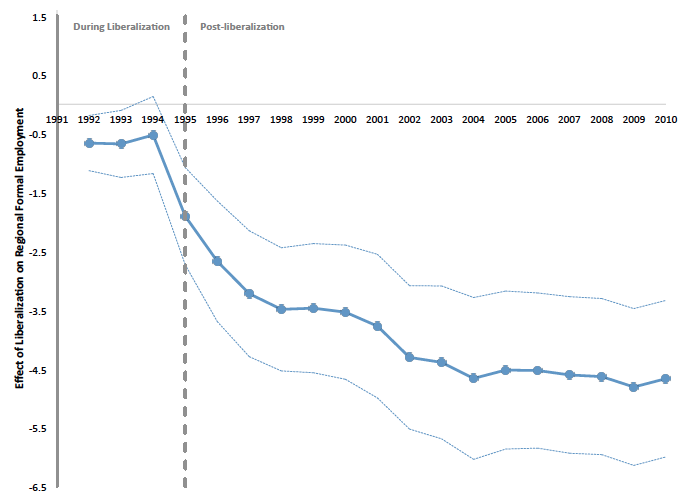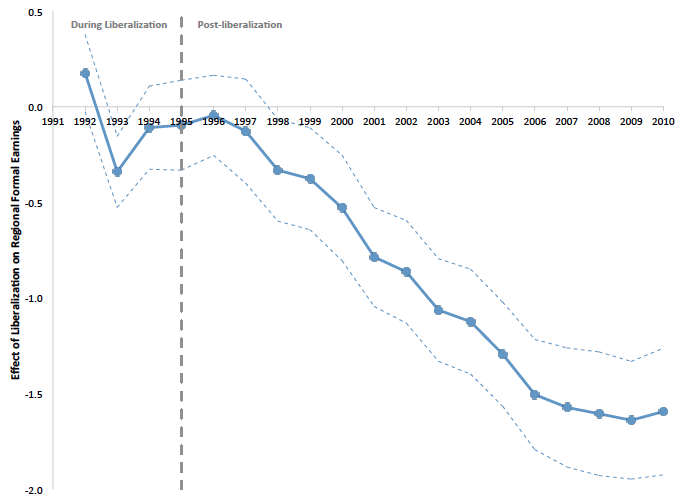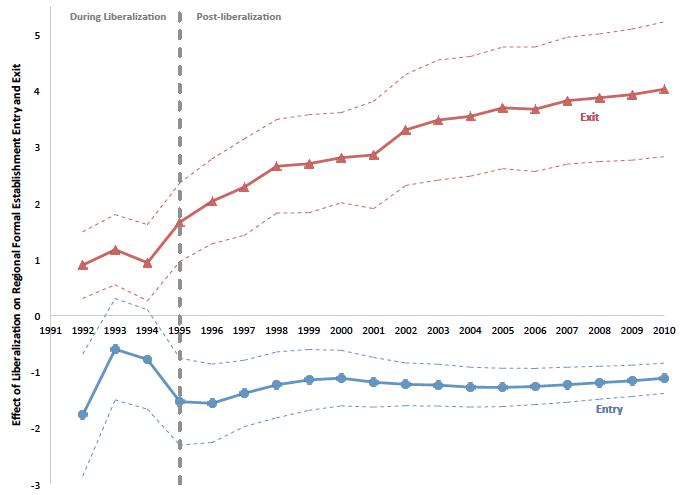
The Brazilian economy did not adjust to trade liberalisation as economists would expect. This column explains these results and their implications
Public sentiment in many high-income countries has turned against globalisation in recent years, fueled partly by the perception that different workers do not evenly share the costs and benefits of freer trade. This idea is not new in international economics. In their seminal paper, Stolper and Samuelson (1941) argued that freer trade is likely to create winners and losers, although the overall economic gains are larger than the losses. Decades of empirical analyses have focused on differences in trade’s effects on wages and employment rates for workers with different education levels or working in different industries. However, only recently have researchers documented substantial differences in the effects of trade and foreign competition on workers in different geographic locations (e.g. Topalova 2010, Kovak 2013, Autor, Dorn, and Hanson 2013).
Uneven terrain
A robust conclusion from the available literature is that trade’s costs and benefits are unevenly distributed geographically, potentially leading to local economies lagging behind or surging ahead as a result of freer trade. Standard economic models of the labour market suggest that these geographic differences will not persist for long. In those models, workers in relatively depressed areas are expected to move to places with more job opportunities, reducing competition for jobs in weaker labour markets and increasing competition in stronger markets. This adjustment process should help equalise the differences across regional economies, suggesting that trade’s effects on regional labour markets will dissipate over time.
Trade liberalisation and Brazil’s regional labour markets
In a recent paper (Dix-Carneiro and Kovak 2017a) we test this prediction in the context of Brazilian trade liberalisation. We find results that contrast sharply with conventional wisdom. Rather than declining over time, the regional effects of freer trade on the formal labour market grow for 20 years following the start of liberalisation, with increasing gaps in wage and employment growth between more positively and negatively affected local economies.
Trade liberalisation in Brazil involved large decreases in tariffs (taxes on imports) that were phased in between 1990 and 1994. Average tariffs fell from 30.5% to 12.8% during this period, with some industries facing very large tariff reductions and others facing much smaller changes. As in most large and diverse economies, different regions in Brazil produce different types of products. Because tariff reductions were different across industries, each region experienced a different average tariff reduction by virtue of its unique mix of industries.
For example, Rio de Janeiro faced a very large tariff reduction because it engages heavily in apparel manufacturing and food processing, both of which experienced larger than average tariff reductions. In contrast, Mata Grande in the state of Alagoas mainly produces agricultural goods, which experienced a small increase in tariffs. Our empirical analysis examines growth in wages and employment for workers in regions that faced larger versus smaller tariff reductions during liberalisation.
Regional growth in wages and employment
Our main data source is the Relação Anual de Informações Sociais (RAIS), covering 1986 to 2010. These administrative data allow us to observe employment, earnings, work location, demographic characteristics, and educational attainment for all formally employed workers in Brazil during this time period. Brazil also has a large informal labour market in which workers do not have access to the benefits and protections provided by formal employment.1
Figure 1 shows how the effect of trade liberalisation on regional formal employment evolved over time. The estimates are negative and grow in magnitude, indicating that regions that were harder hit by liberalisation experienced slow but continuous declines in formal employment compared to other regions. These effects stabilised about 15 years after liberalisation, implying a long process of labour market adjustment. These employment effects fit the standard model of local labour markets outlined above; as workers leave depressed regions, employment there falls compared to other regions.
Figure 1 Effect of liberalisation on regional formal employment

However, as discussed above, the same model predicts the opposite pattern for regional earnings. The short-run effects should be large and then decline over time as worker mobility equalises earnings differences across regions. Figure 2 shows that the opposite happened. The effect of liberalisation on earnings in 2010 was three times larger than the effect in 2000. This pattern contradicts the conventional model and implies that earnings and employment growth in harder-hit regions lagged further and further behind other regions in the decades following liberalisation.
Figure 2 Effect of liberalisation on regional formal earnings

Explaining the regional lag in wages and employment growth
We investigate several explanations that could potentially rationalise these surprising findings, and find empirical support for a mechanism involving a lack of inter-regional labour mobility, the slow movement of capital (the machines and buildings that workers use in production) between regions, and slow changes in local productivity driven by agglomeration economies (described below).
1. Geographic mobility
Although Brazil has a relatively high rate of geographic mobility, the labour market effects we document were not accompanied by systematic migration toward more favorably affected locations. Instead, workers in harder-hit locations adjusted primarily by transitioning to informal jobs in the same region.
2. Movement of capital
Capital slowly reallocated away from badly shocked locations – existing machines and structures slowly depreciated, and investment in new capital was quickly redirected toward more favorably affected markets. Figure 3 illustrates that firm exit increased very gradually following liberalisation, and that investment (measured as firm entry) responded almost immediately and permanently.
Figure 3 Effect of liberalisation on regional formal establishment entry and exit

As suggested by Dix-Carneiro (2014), the slow reallocation of capital led to a steady amplification of the initial local labour demand shock, making workers in harder hit regions even less productive over time compared to those in more favorably affected regions.
3. Local productivity
Our empirical analyses also suggest that agglomeration economies amplify the labour market effects of trade liberalisation; as firms in harder-hit regions leave the market, the productivity of remaining local firms gradually declines, further reducing local wage and employment growth.
Using a simple model of local labour markets, we show that capital reallocation and agglomeration economies together can explain the quantitative scale of the wage and employment effects that we document.
Implications
These results have important implications for our thinking about the labour market effects of trade:
- The adjustment process triggered by trade can be much longer than previously anticipated, with regions facing larger tariff declines experiencing very long periods of depressed growth in earnings and employment.
- The magnitudes of the long-run regional effects are much larger than the short- or medium-run effects reported in prior research.
- When predicting the effects of increased trade or designing policies to help labour markets adjust to large shifts in the competitive landscape, it is essential to understand how capital adjusts across regions and how it interacts with workers in the labour market.
Our work shows that regions facing larger tariff reductions lag behind other regions in terms of wage and employment growth for many years, and these gaps are much larger than previously realised. These large and persistent differences should motivate further research aimed at determining effective policy responses that will help workers in different regions share more equally in the benefits of freer trade.
Photo credit: Marcelo Horn/Getty.
References
Autor, D, Dorn, D and Hanson, G (2013), “The China Syndrome: Local Labor Market Effects of Import Competition in the United States”, American Economic Review 103(6): 2121-2168.
Dix-Carneiro, R (2014), “Trade Liberalization and Labor Market Dynamics,” Econometrica 82(3).
Dix-Carneiro, R and Kovak, B K (2017a), “Trade Liberalization and Regional Dynamics”, American Economic Review (forthcoming).
Dix-Carneiro, R and Kovak, B K (2017b), “Margins of Labor Market Adjustment to Trade”, NBER Working Paper No. 23595.
Kovak, B (2013), “Regional Effects of Trade Reform: What is the Correct Measure of Liberalization?”, American Economic Review 103(5): 1960–1976.
Stolper, W F and Samuelson, P A (1941), “Protection and Real Wages”, Review of Economic Studies 9(1): 58–73.
Topalova, P (2007), "Trade Liberalization, Poverty, and Inequality: Evidence from Indian Districts", in A Harrison (ed.), Globalization and Poverty, University of Chicago Press, pp. 291–336.
Endnotes
[1] In a follow up paper (Dix-Carneiro and Kovak 2017b), we use alternative data to examine the effects of trade liberalisation on the informal labour market.


